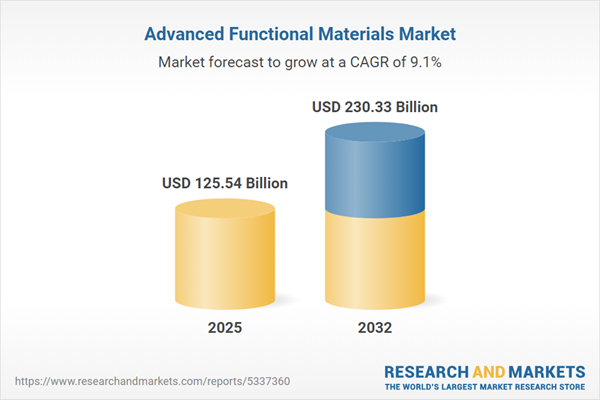Speak directly to the analyst to clarify any post sales queries you may have.
The advanced functional materials market is evolving swiftly, fueled by breakthrough technologies, increased regulatory scrutiny, and new applications across key industrial sectors. Senior decision-makers face a landscape demanding strategic adaptation to seize the latest opportunities and manage emerging risks.
Market Snapshot: Advanced Functional Materials Market Outlook
According to recent analysis, the advanced functional materials market rose from USD 115.09 billion in 2024 to USD 125.54 billion in 2025 and is forecast to grow at a CAGR of 9.06%, reaching USD 230.33 billion by 2032. Growth is being propelled by strong demand for materials that are lightweight, highly durable, and multifunctional. Organizations are guided by evolving market trends, technological advancements, and shifting industry priorities, which are shaping investment and operational strategies in the sector.
Scope & Segmentation
This report offers a focused evaluation of the advanced functional materials market, mapping high-impact opportunities and identifying strategic areas for differentiation along the value chain.
- Material Types: Includes ceramics such as oxide and non-oxide types; composites categorized by fiber-reinforced and particulate; metals divided into alloys and pure metals; polymers differentiated by thermoplastic and thermoset forms. Each material delivers specific performance characteristics, enabling tailored solutions for industry needs.
- Application Areas: Encompasses aerospace and defense for avionics and critical structures; automotive and transportation for components supporting electric vehicles and enhanced safety; electronics and electrical for device miniaturization and reliability; energy storage and generation including batteries, fuel cells, and solar applications; environmental applications such as air and water purification; healthcare for drug delivery and medical devices. These segments illustrate the scope of real-world integration and ongoing research priorities.
- Technology Platforms: Incorporates biomaterials such as bioceramics and biopolymers; conductive polymers like polyaniline and polythiophene; advanced nanomaterials featuring carbon nanotubes, graphene, and quantum dots; photonic materials essential for lasers and optical fibers; smart materials delivering piezoelectric, shape memory, and thermochromic properties. These platforms drive innovation and open new avenues for market differentiation.
- Form Factors: Covers production and usage of bulk solids (blocks, pellets), coatings (dip, spray), fibers (carbon, glass), films and sheets (flexible, rigid), and powders at micro and nanoscale. Each form provides adaptability for diverse industrial environments and manufacturing processes.
- Geographic Coverage: Spans the Americas including the United States, Canada, and major South American economies; EMEA regions encompassing key European markets, the Middle East, and Africa; and Asia-Pacific nations such as China, India, Japan, and South Korea. Broad regional coverage supports localized insights and adaptation to regulatory and supply differences.
Key market players analyzed include 3M Company, BASF SE, Dow Inc., DuPont de Nemours, Inc., Evonik Industries AG, Solvay S.A., Eastman Chemical Company, Arkema S.A., Cabot Corporation, and Wacker Chemie AG, each contributing unique value through innovation, supply capabilities, and global partnerships.
Key Takeaways for Decision-Makers
- Synergies between nanotechnology advancements, sustainability objectives, and collaborative R&D strengthen material adoption in segments such as aerospace, automotive, and energy.
- Emergent policies focused on circularity and reduced environmental impact are stimulating market preference for recyclable and bio-based materials, creating momentum for early adopters.
- Cross-industry alliances—linking suppliers, manufacturers, and research groups—are compressing development timelines and reducing risk by enabling shared innovation and joint ventures.
- Dynamic progress in areas like self-healing, programmable materials, and energy-harvesting solutions is prompting companies to redesign supply strategies and monitor potential disruptors closely.
- Expanding investments in digital modeling and localized processing improve operational agility, enabling swift pivots in response to policy changes or market shocks.
Tariff Impact and Supply Chain Resilience
New U.S. tariffs introduced in 2025 have placed cost pressure on imported ceramics, metal alloys, and specialty polymers. Organizations are responding by reviewing sourcing options, prioritizing domestic suppliers, exploring alternative trade corridors, and investing capital in local processing. These changes have resulted in contract renegotiations, constrained R&D budgets, and increased vertical integration, making supply chain diversification and regulatory engagement critical to sustained resilience.
Methodology & Data Sources
The insights in this report are underpinned by primary research, including interviews with industry leaders and participation in expert panels, as well as thorough secondary reviews of academic literature, patents, and regulatory documents. Rigorous benchmarking, internal quality controls, and peer review processes assure the reliability and objectivity of strategic recommendations.
Why This Report Matters
- Provides executives with practical intelligence to optimize planning, investment decision-making, and risk management in a dynamic materials environment.
- Enables strategic alignment between research, development, and production activities based on performance demands and shifting regional or regulatory requirements.
- Equips leadership to proactively navigate technology, policy, and competitive changes, supporting long-term sustainability and resilience in the advanced functional materials market.
Conclusion
The advanced functional materials sector is being defined by ongoing technological breakthroughs, regulatory change, and resilient value chains. Organizations maintaining focus on innovation, sustainability, and adaptive collaboration will secure future growth in this evolving market landscape.
Additional Product Information:
- Purchase of this report includes 1 year online access with quarterly updates.
- This report can be updated on request. Please contact our Customer Experience team using the Ask a Question widget on our website.
Table of Contents
3. Executive Summary
4. Market Overview
7. Cumulative Impact of Artificial Intelligence 2025
List of Figures
Samples

LOADING...
Companies Mentioned
The key companies profiled in this Advanced Functional Materials market report include:- 3M Company
- BASF SE
- Dow Inc.
- DuPont de Nemours, Inc.
- Evonik Industries AG
- Solvay S.A.
- Eastman Chemical Company
- Arkema S.A.
- Cabot Corporation
- Wacker Chemie AG
Table Information
| Report Attribute | Details |
|---|---|
| No. of Pages | 193 |
| Published | October 2025 |
| Forecast Period | 2025 - 2032 |
| Estimated Market Value ( USD | $ 125.54 Billion |
| Forecasted Market Value ( USD | $ 230.33 Billion |
| Compound Annual Growth Rate | 9.0% |
| Regions Covered | Global |
| No. of Companies Mentioned | 11 |









